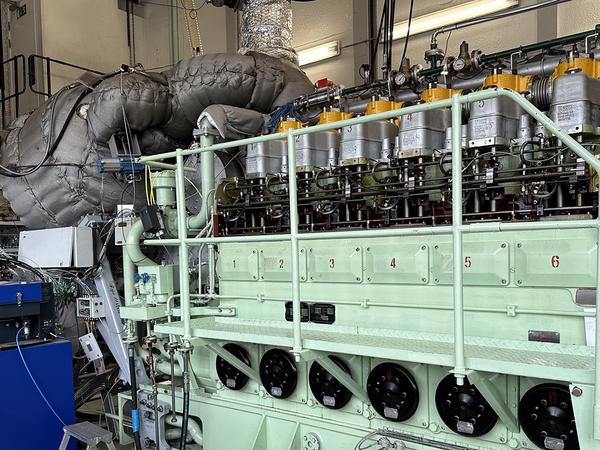MAN ES developing methane slip-reducing tech
German engine maker MAN Energy Solutions (MAN ES) is developing an oxidation catalyst for four-stroke engines that can reduce methane slip.
 PHOTO: MAN ES’ oxidation catalyst for four-stroke engines being tested at its facility. MAN ES
PHOTO: MAN ES’ oxidation catalyst for four-stroke engines being tested at its facility. MAN ES
Methane slip occurs when unburned methane from ship engines escapes into the atmosphere. Since it is unplanned and therefore largely unmeasured, it poses a significant threat to the environment due to methane’s high global warming potential as a greenhouse gas (GHG). Methane emissions have up to 36 times higher global warming potential than carbon dioxide over a century, according to a World Bank study.
The project will “will investigate the operational experience of a pre-turbo methane-oxidation catalyst, ultimately aiming for a 70% reduction of methane emissions,” MAN ES says.
How it works
A pre-turbo methane-oxidation catalyst is a component used in certain types of internal combustion engines, particularly those that run on natural gas. This catalyst is positioned before the turbocharger in the engine's exhaust system. Its primary function is to promote the oxidation of methane (a major component of natural gas) before it reaches the turbocharger.
By oxidising methane before it enters the turbocharger, this catalyst helps to reduce the levels of unburned methane in the exhaust gases.
The development process
MAN ES calls the project “a prototype and technology demonstrator” and is currently analysis the tech's potential on a test engine. It intends to apply it on a full-scale engine, too.
The tech has been developed at MAN ES’ headquarters in Augsburg, Germany, and is currently being tested at the engine maker’s facility in Frederikshavn, Denmark.
Field testing onboard a vessel is slated for the first quarter of 2024.
"As no commercially-available technology yet exists on the market, the field test will be the first time ever that a vessel sails with a methane catalyst,” MAN ES’ head of exhaust gas aftertreatment Hans-Philipp Walther says.
Hindrances and ways
The German engine maker has been exploring various materials to make the catalyst work.
“Previous attempts to use precious-metal catalysts have resulted in the catalyst elements themselves becoming significantly expensive. Additionally, due to poisoning, you either have to use a lot of such material or install additional technology to protect it,” Walther says.
The new project has chosen a catalyst material without precious metals, which is sulphur resistant. Sulphur resistance is “is an important design consideration as – even during gas operation – pilot- and lube-oils contain traces of sulphur.”
Sulphur resistance also allows the catalyst to be preheated in diesel mode before switching to gas operation, MAN ES explains, as “a cold catalyst would not be able to perform optimally and methane slip would occur.”
The pre-turbocharger integration of the catalyst is also crucial “because of the exhaust-gas pressure and temperature level there,” MAN ES says.
By Tuhin Roy
Please get in touch with comments or additional info to news@engine.online





